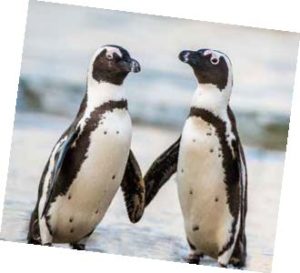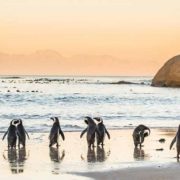Yes it’s true there are Penguins in Paradise
by Tim Tetzlaff
Naples Zoo’s Director of Conservation
 When we imagine the range of giraffe and lions, we conjure up visions of Africa. When it comes to penguins, we shiver at the thought of ice-covered Antarctica. In reality, only a few species of penguins inhabit the frozen continent. The others inhabit the islands of the southern ocean as well as the coasts of South America and Australia – and one species makes its home on the shores of Africa. African penguins, also known as black-footed penguins, live along the rocky shorelines and islands of South Africa and Namibia.
When we imagine the range of giraffe and lions, we conjure up visions of Africa. When it comes to penguins, we shiver at the thought of ice-covered Antarctica. In reality, only a few species of penguins inhabit the frozen continent. The others inhabit the islands of the southern ocean as well as the coasts of South America and Australia – and one species makes its home on the shores of Africa. African penguins, also known as black-footed penguins, live along the rocky shorelines and islands of South Africa and Namibia.
These flightless birds enjoy a subtropical climate similar to ours here in Naples – which is where you can now see African penguins for a limited time. Naples Zoo is hosting two pairs of African penguins through April 15, 2018. In celebration of our visitors, we’re sharing the penguin fun throughout the gardens where you can learn what many of our other animals have in common with them – from alligators to zebras! For example, alligators and penguins have something called countershading. This helps them camouflage so they can both catch food and avoid predators. It works like this: seen from below, a lighter stomach allows them to blend in with the bright sky; seen from above, a dark back makes them hard to see in the murky water below.
Unfortunately, even as well adapted as they are to their environment, African penguins face numerous threats. The International Union for Conservation of Nature classifies them as “Endangered” as they have plummeted from nearly one million breeding pairs in the 1920s to less than 30,000 breeding pairs today. Much damage was done by people harvesting the guano (penguin poo) who sold this white gold to farmers to fertilize their fields. While you might think scraping away waist deep deposits of guano would be nice housecleaning help, the penguins needed the guano to burrow in to make nests to protect their chicks from warm temperatures.
Without that protection, adults can leave the chicks unprotected and vulnerable to predators as they cool off in the water and some chicks suffer directly from the heat. To help fix this, Naples Zoo was one of the top contributors to a campaign organized by the Association of Zoos and Aquariums to create artificial nest boxes. A sample of one of these can be seen at the zoo. Another critical issue for penguins is overfishing of their preferred food. While we think of penguins as cute and cuddly, they are fearsome to fish. Their beak is sharp and hooked, while inside there are spines on the palate and tongue to insure a slippery fish would have a hard time getting away. But if the fish aren’t there to catch, none of that matters. As part of the mission of this temporary exhibit, educators and interactive graphics share how we can help the health of our oceans by being smart about what seafood we order. With about a third of assessed fish populations over-fished and over half fullyfished, choosing to eat sustainably helps the oceans and its penguins, dolphins, and other species as well as the
fisherman who make their living on the waters.
Learn more at www.napleszoo.org/seafood. You’ll also have a chance to support an organization that helps African penguins in distress each year including ones impacted by oil spills. With your help, we can make good news for penguins and other marine life. And one final bit of penguin trivia for the season’s parties. Forget what you’ve seen in the Christmas soda commercials and your favorite cartoons because polar bears and penguins never meet in the wild. The giant white bears live in the arctic regions of the northern hemisphere. Penguins live exclusively in the southern hemisphere except the Galápagos penguins who just barely cross the equator. Just so you know.



Leave a Reply
Want to join the discussion?Feel free to contribute!